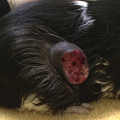Guinea Pig Lumps and Bumps
Guinea pigs can get a wide variety of masses, growths, and bumps on their bodies. Although we cannot diagnose a mass just by looking at or feeling it, there are some more common masses that occur.
Trichofolliculoma
A Trichofolliculoma is another word for a benign basal cell epithelioma. This is the most commonly diagnosed “bump” on a guinea pig. They are commonly cystic, meaning they produce a sebaceous type of substance that is of a toothpaste consistency. These bumps vary in size ranging from a small nodule to a large cavitated and malodorous mass. Catching them while they are still small is ideal because the only way to cure/treat them is to surgically excise the entire capsule. If the entire capsule is not removed (i.e. the capsular substance is only debrided and cleaned out), then the cells will continue to overproduce the sebaceous material and refill. 
Abscesses
While the trichofolliculoma masses can look similar to an abscess (an accumulation of bacteria and inflammatory debris (i.e. pus)), they are different in origin. While abscesses can happen anywhere on/in the body, a common place we can see abscess occur in guinea pigs is the lymph nodes in the neck. This is called cervical lymphadenitis and is typically caused by a certain type of bacteria, Streptococcus zooepidemicus. If you would like to learn more about this specific disease, see Caseous Lymphadenitis under our Guinea Pig page on this website.
Neoplasms
Types of malignant tumors are not as common as the other masses noted above; however, they can be the cause of the mass on a guinea pig. The most common type of malignant neoplasm diagnosed from a “lump or bump” on a guinea pig is lymphosarcoma. Diagnosis can only be made by sending a sample of the mass to a laboratory and this can be done by either fine-needle aspirate (using a needle to sample the cells of the mass) or surgical excision and biopsy (sending the actual tissue of the mass into the laboratory).
Since many of these lumps and bumps can look similar to the naked eye, if you notice a mass on your guinea pig, please consult a veterinarian for diagnosis and treatment options.

